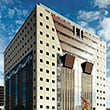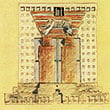Portland Municipal Services Building
Portland Municipal Services Building
For more than 100 years, American civic buildings embraced the form of neoclassical temples. Then the modernists pushed back with sleek, stark boxes. But in 1982, the formerly modernist architect Michael Graves fired a resounding shot in the postmodernist revolution with his Portland Building.
Graves lived and studied in Rome in the early 1960s, and the influence of the classical architecture he encountered there – especially the heroic, ornamented facades of civic buildings – can be seen in his postmodern work.
With the Portland Building, by embracing color, classical iconography, and even a sense of playfulness, he didn’t just break the rules of modernism. He gave major momentum to a building style that became widely known thereafter as postmodernism.
Like his fellow modernist Robert Venturi, Michael Graves wasn’t necessarily trying to coin a style. But his work for many years thereafter became synonymous with the postmodernist movement. The Portland Building was so influential to postmodernism that it was listed on the National Register of Historic Places in 2011.





